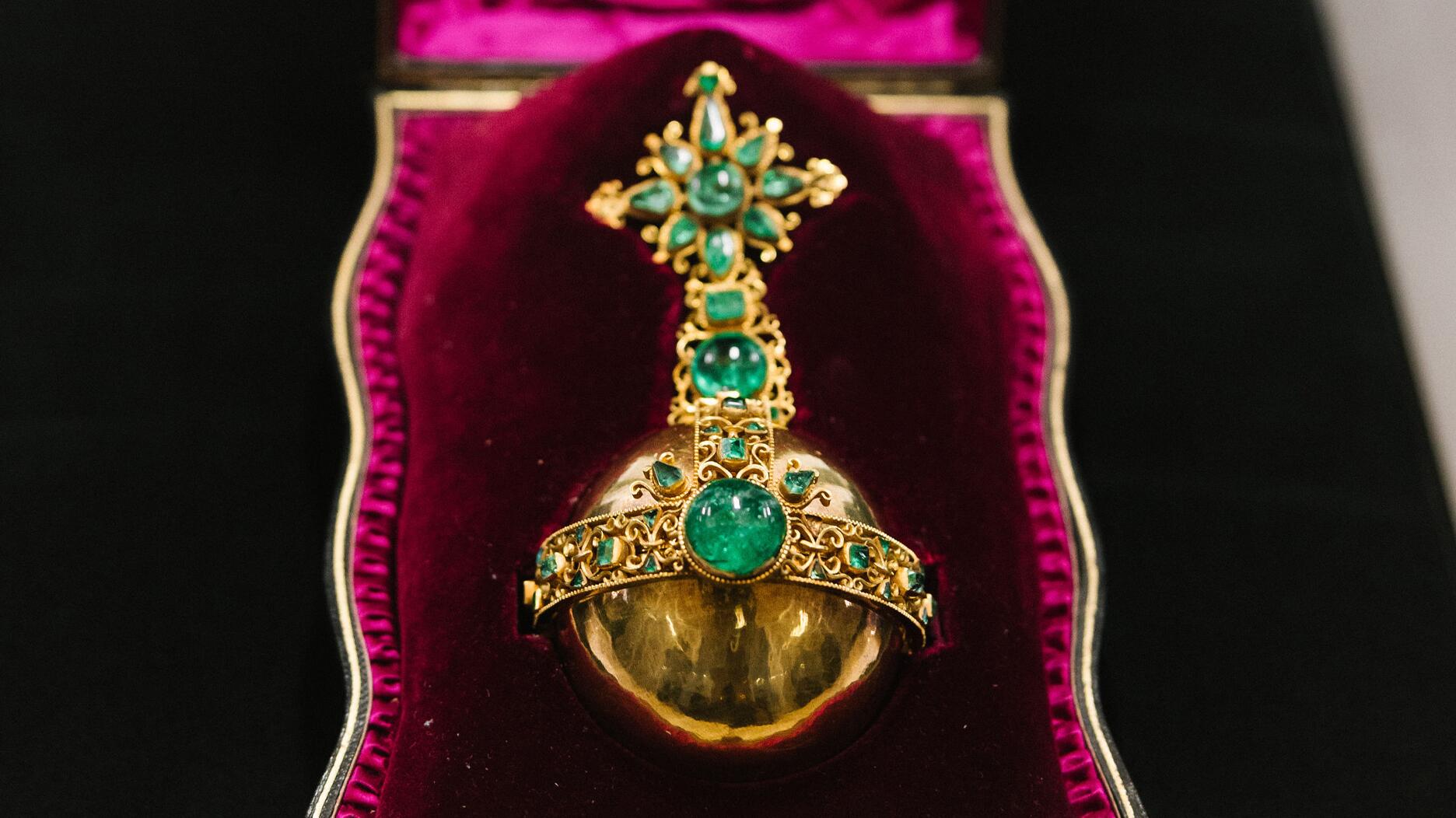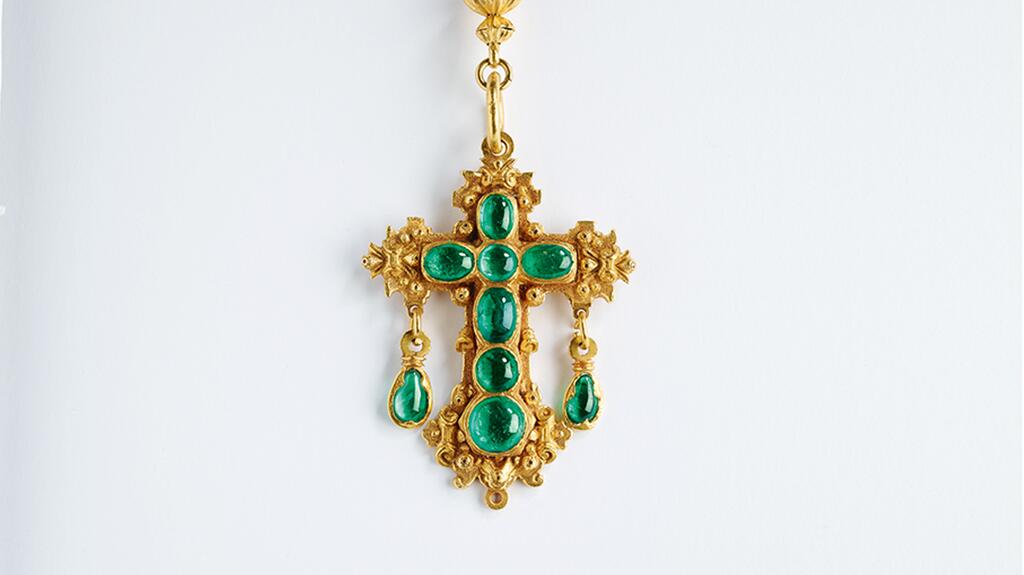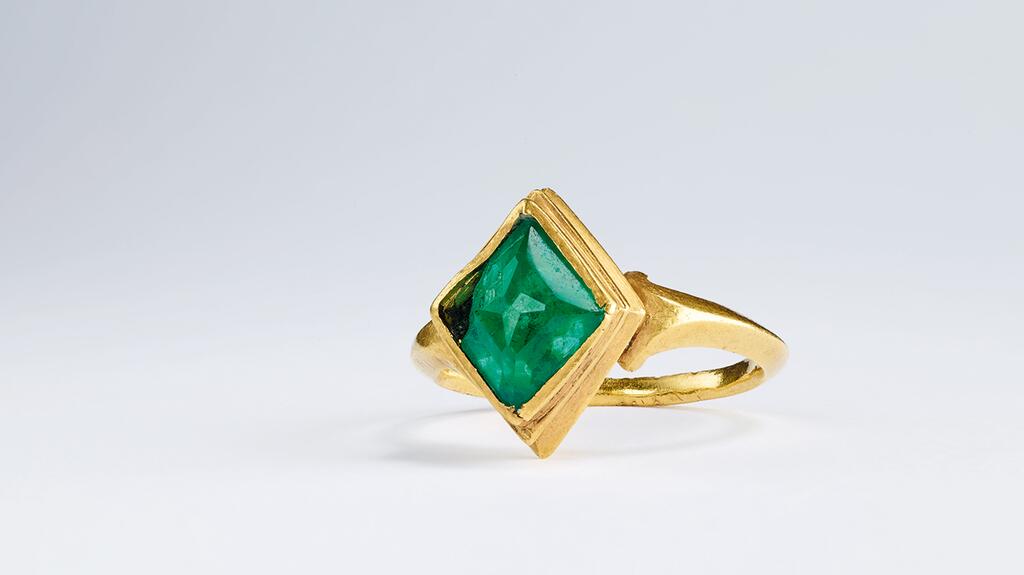Muzo’s Collection of Shipwrecked Emeralds Makes US Debut

This royal orb, or globus cruciger, containing Muzo emeralds was recovered from the wreck of the Nuestra Señora de Atocha in 1985. It is now part of the Muzo Private Collection.
"New York—Mined in Colombia, Muzo emeralds long have been one of the world’s most coveted gemstones.
While historians believe indigenous peoples were in the Muzo mines as early as 500 A.D., the Spanish, who colonized Colombia starting in the 16th century, often are credited with the discovery of the verdant gems.
With the Spanish in power, gems flowed out of the country alongside other South American commodities, like gold, silver, and tobacco, on global trade routes for royals and Mughal emperors seeking the most spectacular specimens, said Muzo Emerald Colombia, the sales and marketing arm of the company that now owns and operates the famed mines.
Three pieces of emerald jewelry in the cargo aboard one particular ship, which never completed its voyage, now comprise the Muzo Private Collection, which made its U.S. debut last month at The Winter Show, an invite-only premiere art, antique and design fair in New York.

Muzo acquired the Atocha cross, along with the royal orb and the Atocha ring, in 2014. Today, they are the three jewels that comprise the Muzo Private Collection. They each contain emeralds from the Muzo mine and were discovered in the wreckage of sunken Spanish ship the Nuestra Señora de Atocha.
In 1622, Spanish galleons, including the Santa Margarita and the Nuestra Señora del Rosario, departed from ports in present-day Colombia, Panama, and Cuba on a return voyage.
One vessel owned by King Philip IV of Spain, the Nuestra Señora de Atocha, was carrying a nearly unfathomable load of cargo.
It took two months to load all the goods on board, according to the Mel Fisher Maritime Museum in Key West, Florida.
Muzo said the cargo had an estimated value between $250 and $500 million.
Unfortunately, the ship, also carrying 265 people, got caught in a storm and sank, the museum said, and while rescuers tried to retrieve what they could, they eventually had to mark the site of the wreck and move on to rescue people and treasure from the other ships caught in the storm.
Not long after, a second hurricane struck, further destroying the Atocha and scattering the wreckage for miles.
In 1969, American treasure hunter Mel Fisher began searching for the ship’s sunken remains, Muzo said.
In 1973, silver bars matching the weights and tally numbers on the ship’s cargo manifest were found, confirming the hunters were close, according to the museum, and in 1975, more cargo was recovered.
The Santa Margarita was discovered in 1980 and, finally, in July of 1985 the Atocha—the “motherlode”— was found and excavation began.
The loot included a small cache of rough Muzo crystals, though thousands more gems are thought to remain at the bottom of the ocean, said Muzo.
Some finished emerald jewelry survived the shipwreck, including lavish gold jewels, crosses, brooches and other ornaments, each characteristic of 17th century Spanish court style.
Three pieces found their way back to Muzo, which said it was those existing cargo documents that helped identify and confirm the emeralds’ origin.
“We have three of the most important pieces that contain Muzo emeralds in a piece of jewelry,” said Gabbi Harvey, the company’s head of business development.
Muzo invested in the pieces in 2014 – the royal orb, a cross on a necklace, and a ring.

The Atocha ring features a single 2.5-carat emerald with a slight chip. Muzo said it is the property of Tasii Fisher, the only daughter of Mel Fisher, the treasure hunter who discovered the wreck of the Atocha in 1985.
While Harvey described the pieces Muzo acquired as the “most significant” recovered from the shipwreck, they are not the first emeralds from the Atocha to make headlines.
In December 2022, Sotheby’s New York auctioned a 5.27-carat octagonal step-cut emerald ring crafted from one of the rough emeralds discovered in the wreckage.
It sold for $1.2 million, blowing its $50,000-$70,000 pre-sale estimate out of the water.
The ring had been the engagement ring of author Mitzi Perdue, wife of chicken magnate Frank Perdue, one of the financial backers of Fisher’s search and recovery mission.
The recovered goods bring new insights into the workings of the world during that time in history.
Specifically, the finished jewelry that was recovered demonstrates the sophisticated techniques and craftsmanship of 17th century jewelers, Muzo said.
The orb with the cross, also known as a globus cruciger, was traditionally used as an emblem of Christ’s power by Christian monarchs or to indicate Christ’s sovereignty over the cosmos.
The one recovered from the shipwreck is thought to have been a processional orb used in annual celebrations by the church for Easter or saints’ days.
Elegantly designed, with scrolled Spanish cannetille filigree and Muzo emeralds, it represents the world, the company said, and the cross overlaid onto the orb speaks to the divine and God’s omnipresence.
Because the orb contains so many emeralds, 37, it most likely was made by goldsmiths in Colombia, Muzo said.
The other two pieces were named in honor of the Nuestra Señora de Atocha.
The Atocha cross is a 22-karat yellow gold and emerald cross found in the hull of the sunken vessel. Muzo said it represents the “most prized of all artifacts” from the wreck.
The Atocha ring is a high karat gold ring typical of the wealthier class during the 17th century. It is a size 5.5 and features a single 2.5-carat emerald with a slight chip.
Muzo said the ring is the property of Tasii Fisher, Mel Fisher’s only daughter and youngest child.
In 2018, Muzo manufactured its own collection inspired by the Atocha pieces, the Heritage Collection.
“I think what’s important for us as well is [looking] at these pieces that were created in the 1700s and [seeing that] the craftsmanship of these pieces was so innovative and so up-to-today. The manufacturing hasn’t really changed, the craftsmanship hasn’t really changed,” Harvey said.
“[The Heritage Collection] was an opportunity to bring back the past.”
The Muzo Private Collection, as well as some pieces from the Heritage collection, were on view at The Winter Show in New York in January.
It was the collection’s first time on public display in America and added to the discussion of what’s next for these irreplaceable artifacts of history.
“They were received beautifully [at the show], and the story is so incredible, and we do think it needs to be shared with everyone else,” Harvey said.
“We didn’t realize how many people knew about the Atocha and how significant it was. It’s really for a shame for us to keep these wonderful artifacts in a safe, so we’ve had brief discussions that perhaps we will put it in a ... "
https://nationaljeweler.com/articles/12 ... s-us-debut